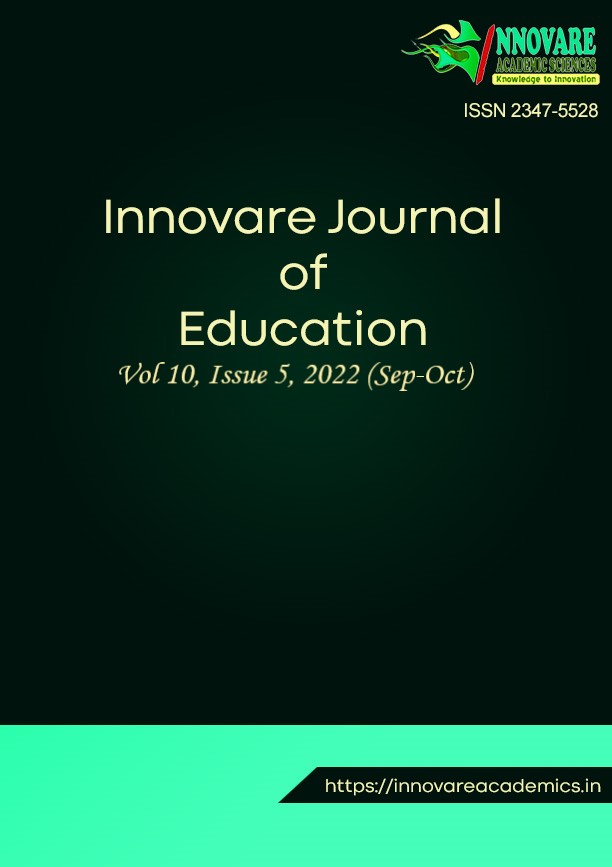On Improving the Students’ Combinatorial Thinking Skill in Solving Rainbow Antimagic Colouring Problem on Cryptography for E-Commerce Security Systems under the Implementation of Research-Based Learning with STEM Approach
DOI:
https://doi.org/10.22159/ijoe.2022v10i5.45596Keywords:
combinatorial thinking, rainbow antimagic colouring, research-based learning, STEM approachAbstract
Combinatorial thinking is the process of obtaining multiple solutions for discrete problem-solving. Combinatorial thinking skills have several indicators: identifying several cases, recognizing patterns from all cases, generalizing all cases, proving mathematically, and considering other combinatorial problems. The learning approach in schools is growing along with the development of science and technology, one of the approaches used in STEM. STEM education focuses students on solving problems in everyday life with the help of science, technology, engineering, and mathematics. This paper aimed to analyze the students’ combinatorial thinking skills after using a research-based learning worksheet with a STEM approach to solving the rainbow antimagic colouring problem. This study uses a mixed-method where this research combines qualitative and quantitative methods. The subjects of this research are undergraduate students of Mathematics Education, University of Jember. This study involved two classes, namely the experimental and control classes, where the researcher gave the two classes different treatments. The t-test compares students’ combinatorial thinking skills between the experiment and control classes after using research-based learning tools with a STEM approach for solving the rainbow antimagic problem. The homogeneity test results on the pre-test items indicated a significance value of .789 > .05, which indicates that the two classes are homogenous. The independent sample t-test score is .020 < .05, which means the difference is significant. It concludes that implementation of the research-based learning materials with a STEM approach can improve the students’ combinatorial thinking skills in solving the rainbow antimagic colouring.
Downloads
References
Al Jabbar, Z. L., Dafik, Adawiyah, R., Albirri, E. R., & Agustin, I. H. (2020). On rainbow antimagic colouring of some special graphs. Journal of Physics: Conference Series ICOPAMBS 2019, 1465, 1-8. https://iopscience.iop.org/article/10.1088/1742-6596/1465/1/012030
Anggraeni, Dafik, & Tirta, I. M. (2019). The analysis of the application of discovery learning in improving student’s combinatorial thinking skill to solve local super antimagic face colouring problem. Journal of Physics: Conference Series, 1211, 1-15. https://iopscience.iop.org/article/10.1088/1742-6596/1211/1/012086
Budi, H. S., Tirta, I. M., Agustin, I. H., & Kristiana, A. I. (2021). On rainbow antimagic colouring of graphs. Journal of Physics: Conference Series ICOPAMBS 2020, 1832, 1-10. https://iopscience.iop.org/article/10.1088/1742-6596/1832/1/012016
Dafik, Susanto, F., Alfarisi, R., Septory, B. J., Agustin, I. H., & Venkatachalam, M. (2021). On rainbow antimagic colouring of graphs. Advanced Mathematical Models & Applications, 6(3), 278-291.
Ebal, C. D., Luga, M. J. F., Flores, M. R. O., Joma, D., Zabala, P., Buan, A. T., & Yuenyong, C. (2019). Linear equations in two variables STEM education learning activities: Developing the household power consumption calculator app, Journal of Physics: Conference Series - International Annual Meeting on STEM Education (I AM STEM) 2018, 1340, 1-7. https://iopscience.iop.org/article/10.1088/1742-6596/1340/1/012048
Gita, R. S. D., Waluyo, J., Dafik, & Indrawati. (2021). On the shrimp skin chitosan STEM education research-based learning activities: Obtaining an alternative natural preservative for processed meat. IOP Conference Series: Earth and Environmental Science, 747, 1-13. https://iopscience.iop.org/article/10.1088/1755-1315/747/1/012123
Maylisa, I. N., Dafik, Hadi, A. F., Wangguway, Y., & Harjito, L. O. (2020). The influence of research-based learning implementation in improving students’ combinatorial thinking skills in solving local irregularity vertex r-dynamic colouring. Journal of Physics: Conference Series - ICCGANT 2019, 1538(1), 1-12. https://iopscience.iop.org/article/10. 1088/1742-6596/1538/1/012090
Nazula, N. H., Dafik, & Slamin. (2019). The profile of students’ creative thinking skills in solving local antimagic vertex colouring problem in research-based learning. Journal of Physics: Conference Series - ICCGANT 2018, 1211(1), 1-15. https://iopscience.iop.org/article/10.1088/1742-6596/1211/1/012109
Rahim, F. R. (2019). Implementation of research based learning (RBL) in integrated science courses in the physics education study program [Implementasi research-based learning (RBL) pada mata kuliah ipa terpadu di program studi pendidikan fisika]. Jurnal Eksakta Pendidikan (JEP), 3(1), 82-91. https://jep.ppj.unp.ac.id/index.php/jep/article/view/321
Septory, B. J., Utoyo, M. I., Dafik, Sulistiyono, B., & Agustin, I. H. (2021). On rainbow antimagic colouring of special graphs. Journal of Physics: Conference Series ICOPAMBS 2020, 1836, 1-12. https://iopscience.iop.org/article/10.1088/1742-6596/1836/1/012016
Singh, V. (2014). Research-based learning: an igniting mind. International Journal for Research in Education(IJRE), 3(6). 21-24 https://www.raijmr.com/ijre/wp-content/uploads/2017/11 /IJRE_2014_vol03_issue_06_04.pdf
Subekti, H., Purnomo, A. R., Susilo, H., Ibrohim, I., & Suwono, H. (2018). Comparison of student achievement in agricultural biotechnology-STEM integrated using research-based learning. Journal of Physics: Conference Series - MISEIC 2018, 1108, 1-6. https://iopscience.iop.org/article/10.1088/1742-6596/1108/1/012100/meta
Sulistiyono, B., Slamin, Dafik, Agustin, I. H., & Alfarisi, R. (2020). On rainbow antimagic colouring of some graphs. Journal of Physics: Conference Series ICOPAMBS 2019, 1465, 1-8. https://iopscience.iop.org/article/10.1088/1742-6596/1465/1/012029
Susiani, T. S., Salimi, M., & Hidayah, R. (2018). Research-based learning (RBL): How to improve critical thinking skills?. SHS Web of Conferences, 42, 1-6. https://www.shs-conferences.org/articles/shsconf/pdf/2018/03/shsconf_gctale2018_00042.pd
Syahputra, E. (2016). Combinatorial thinking - analysis of student difficulties and alternative solution. Researchgate - The Third Annual International Seminar On Trends In Science and Science Education, 1–13. https://www.researchgate.net/publication/321379672_Combinatorial_Thinking_Analysis_of_Students%27_Difficulties_and_Alternative_Solution
Torlakson, T. (2014). INNOVATE: A blueprint for science, technology, engineering, and mathematics in California public education. Californians Dedicated to Education Foundation.
Published
How to Cite
Issue
Section
Copyright (c) 2022 dafik, Jean Claudia Joedo, I Made Tirta

This work is licensed under a Creative Commons Attribution 4.0 International License.





